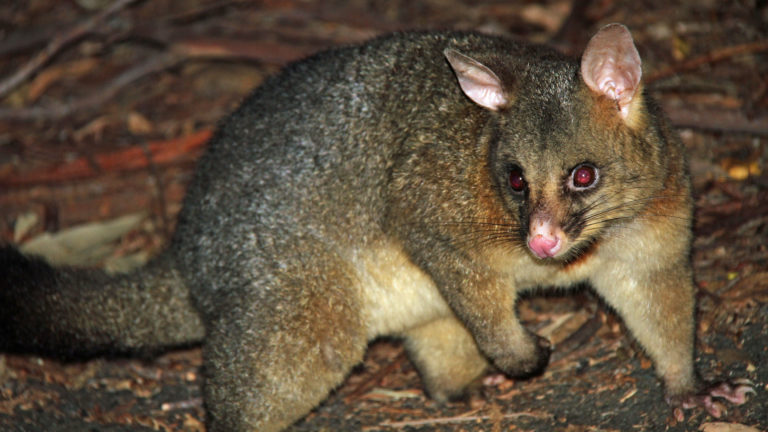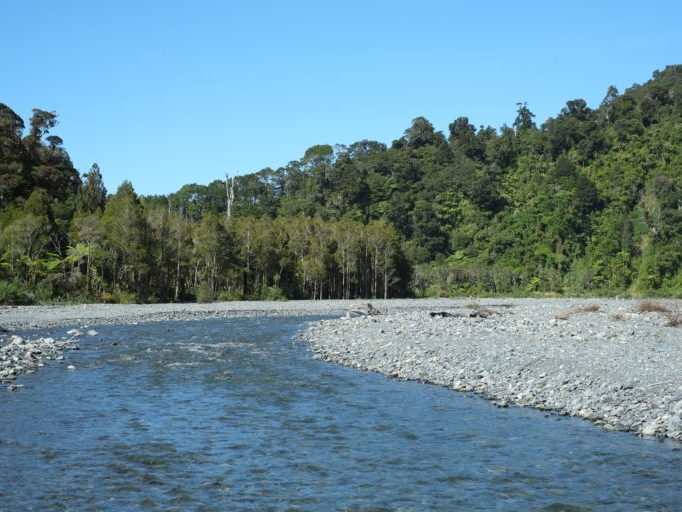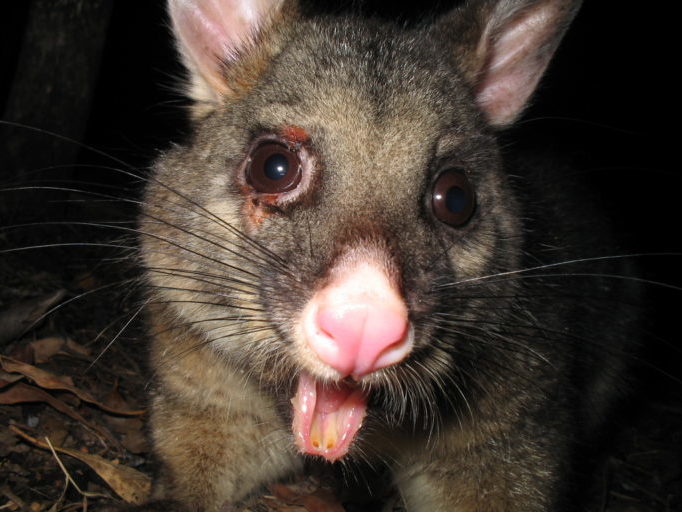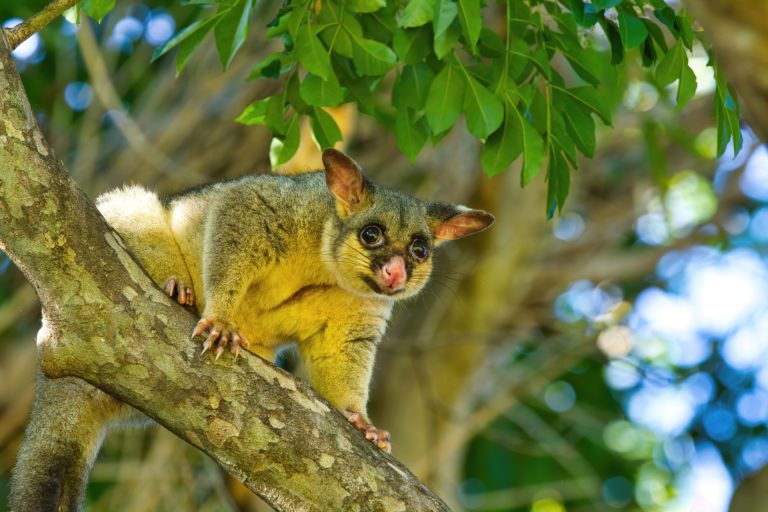Reinvasion by predators, of previously cleared areas, is one of the many challenges of becoming predator free. We can’t fence huge tracts of wilderness – but we can potentially make use of natural barriers. Possums, for example, may be reluctant to cross rivers.

Anecdotal reports that rivers are an obstacle to possum expansion have been around for a while. Recently, Briar Cook, Nick Mulgan and Helen Nathan from Zero Invasive Predators (ZIP) decided to put the possibility to the test scientifically and report on their findings in the New Zealand Journal of Ecology. There’s more research to be done, but initial results sound promising.
“Possum home range size varies between high-density and low-density populations, with low density populations generally exhibiting larger home ranges. After control, previously high-density populations are more likely to exhibit movement behaviour described as home range expansion or the vacuum effect, particularly in the absence of landscape constraints. These changes have been observed to occur within a few weeks of control.”
There is geographic evidence and genetic evidence that watercourses can act as obstacles to possum movement, and so may provide some natural protection to landscape scale eradicated areas.

“We aimed to assess whether the Orongorongo River (Remutaka Forest Park) impeded home range expansion behaviour on the edge of a high-density population, following possum control to low density directly across the river. The trial site ranged in elevation from 80−460 m above sea level, was mainly broadleaf/podocarp forest, and had a mean annual uncontrolled possum population density between 6.5−13.7 per ha. Flow data for the Orongorongo River recorded by Greater Wellington Regional Council at Truss Bridge (8 km upstream from our study site) were used to approximate the flow rate at our study site during the trial. The mean daily flow rates during the study period were comparable with the flow rates for the same period in the previous and following years.”
In order to carry out the study, the research team negotiated with OSPRI and the Department of Conservation to establish a 250 hectare toxin exclusion zone, covering about 4 kilometres along the true right forest margin of the Orongorongo River, when an aerial 1080 toxin operation was carried out in July 2017 to control TB-infected possums. The riverbed habitat was also excluded from 1080 treatment, as is typically the case in 1080 operations.
For the duration of the trial, 275 Trapinator™ possum kill traps were installed at 20 m spacing around the boundary of the exclusion zone, to prevent possums invading the controlled area. All boundary traps were cleared and reset every 7−10 days. A non-toxic biomarker was also fed to possums inside the exclusion zone.
“Pyranine is a non-toxic biomarker which temporarily stains the digestive tract of animals fluorescent green under UV light. Possums that eat bait containing pyranine become marked internally soon after consumption, and green fluorescent flecks can also be found inside the mouth cavity and around the anus. Pyranine added to cereal pellet bait has an internal marking period of about four days for possums, requiring regular application to ensure ongoing marking of the target population. Despite this, the relatively low cost and ease of bait production made pyranine our chosen method for marking the possum population in the exclusion area on the true right side of the river.”
“Non-toxic, pyranine-laced (0.2%), 6 g cereal baits were aerially broadcast over 120 ha of the exclusion zone bordering the river. The first pyranine-laced baits were sown six days after the 1080 operation, at an average rate of 2.25 kg per hectare, and then every 6−11 days throughout the nine weeks of the trial. Bait bags containing six of the same pyranine-laced baits were stapled to trees along the true right river edge. These were fixed at about chest height, mostly about 20 metres apart, and none more than 50 metres apart. The bait bags were deployed between aerial sowing applications to maximise the length of time marked bait was available to possums at the river edge.”
A total of 205 possum leghold traps were installed along an existing 4WD track on the true left of the river, parallel to the exclusion zone on the true right. Traps were set at 20 metre spacing and monitored remotely.
“Each trap set was fitted with an automated reporting transmitter node. This OutPost reporting system, (ZIP, Wellington) enabled remote monitoring of each trap via VHF transmission and satellite communication. To facilitate this, a temporary satellite internet system was installed at the Manaaki Whenua – Landcare Research Base, located about 500 m upstream from Paua Hut, and about 200 m upstream of the first leghold trap. The OutPost system and its operation complied with the Animal Welfare Act and Ministry for Primary Industries guidelines on using remote reporting systems for live capture trapping. Any traps reporting as sprung overnight were manually checked within 12 hours of sunrise, as legally required.”

Possums caught in these leghold traps were killed humanely and checked to see whether they had traces of pyranine, which would indicate they had come from the control exclusion zone across the river.
“All possums were examined externally and internally (through dissection) visually and using a UV light. Several detections of external fluorescence (guard hairs, whiskers and fur patches) with no corresponding internal fluorescence prompted trials at the ZIP Animal Behaviour Facility in Lincoln, which confirmed the presence of natural fluorescence in possum fur and urine from animals that had not consumed pyranine baits. Therefore, internal examination was considered the only reliable method of determining pyranine consumption, and any possums with only external fluorescence were recorded as unmarked by pyranine.”
No pyranine-dyed possums were found to have crossed the river from the control exclusion zone to the less-densely populated left side of the river where possum numbers had now been reduced by the 1080 control operation.
“Over 59 nights following the first pyranine drop (12,095 trap nights, 5 August–3 October 2017), 44 possums were caught in the leghold traps on the true left side of the river. None of these showed evidence of pyranine consumption.We did not record any marked possums that had crossed the river during our trial, consistent with previous experimental and anecdotal evidence that possums seldom traverse water bodies.”
The ‘barrier effect’ of a river may depend on the nature of the river, however – with factors such as water flow, the size of channels and vegetation having an influence.
“The Orongorongo River is usually made up of several small channels separated by wide, exposed areas of gravel. The average flow rate at Truss Bridge between 5 August and 3 October 2017 was 3.21 metres per second, with actual values ranging from 0.88−30.5 metres per second. We would consider both the average rate and the minimum actual rate to be relatively low, and physically possible for a possum to cross.”
“There was very little established vegetation in the riverbed at the time of the study; however, vegetation cover can vary from 5−22%, depending on the frequency and severity of floods. The vegetation that was present comprised Raoulia tenuicaulis (scabweed), and sporadic instances of Buddleia davidii and Kunzea ericoides (kānuka) along the margins. Because of the lack of vegetation cover and food availability, we consider it likely that any obstacle effect of this river is not solely due to the presence of a water body, but also to the largely unsuitable habitat of the braided river system as a whole.”
If the 44 possums caught in leghold traps didn’t come from the control exclusion zone, then where did they come from? How did they survive the aerial 1080 operation? Other areas, such as public huts, were also excluded from the 1080 drop.
“Of the 44 unmarked possums caught on the true left of the river, 33 were caught inside the 1080 exclusion zones surrounding public huts and were unlikely to have been exposed to the toxin. The remaining 11 possums either survived exposure to the 1080 operation, wandered from nearby exclusion zones, or originated on the true right (but had not consumed pyranine recently) and crossed the river. When reduced to low density, resident possum home ranges can rapidly become larger than average. This suggests that possums originating in exclusion zones on the true left were moving around more following density reduction, and therefore encountering the leghold traps.”
“The lack of marked possums on the true left, at the very least, indicates that possums rarely inhabit home ranges that span land on both sides of this braided river. At the most it indicates that home range expansion did not occur across the Orongorongo River in the nine weeks following control.”

This is just an initial study involving one river. More research involving different river types needs to be done to better understand how effective rivers are as a barrier to possum expansion.
“While home range expansion in adult possums in the Orongorongo Valley appeared to be limited by the presence of the river during our study, this may not be the case for other types of possum movement, or at other times of year. Dispersing sub-adults play a key role in repopulating controlled areas by moving large distances.”
“Dispersing sub-adult possums are known to sometimes cross the Orongorongo River. Owing to the constraints imposed by the timing of the 1080 operation, this trial was undertaken outside the peak sub-adult dispersal season. A future trial carried out over several months spanning the sub-adult dispersal period could strengthen the evidence around the use of rivers as obstacles to possum movement or highlight areas for further investigation.”
Possum crossing rates over narrow rivers with suitable habitat directly bordering such waterways should also be investigated, to isolate the effects of different river types, the researchers believe.
“While rivers are used as boundaries in aerial 1080 operations, the evidence supporting this use is largely anecdotal and qualitative. If successful, these further trials could continue to build evidence for the use of rivers as a key component of a strategy to protect landscapes from possum reinvasion and help to enable large chunks of the country with natural river borders to be targeted for possum eradication.”
The full research report is published in the New Zealand Journal of Ecology and freely available online.
Rivers as obstacles to home range expansion by the brushtail possum (2020)

